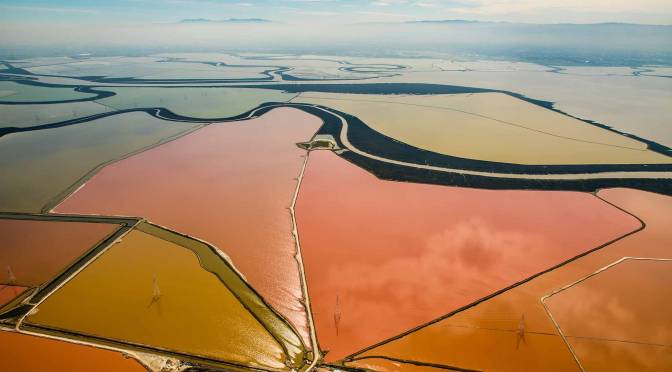More than that, however, they cap a 40-year David vs. Goliath struggle that pitted environmentalists against the powerful California Department of Transportation, resulting in multiple lawsuits and a variety of proposals, including a six-lane freeway to bypass the treacherous stretch of Highway One between Pacifica and Montara that ribbons past Devil’s Slide.
“Caltrans in the early ‘70s was a bunch of engineers that said, ‘get out of my way and let me build my road,’” said Lennie Roberts, legislative advocate with the Committee for Green Foothills, an environmental group based in Palo Alto. “They did not interact with the community and they didn’t want the community to have any say about their projects.”
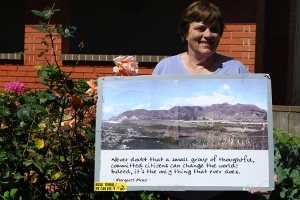 Lennie Roberts with a quote from Margaret Mead that helped inspire pro-tunnel supporters. (Credit: Sheraz Sadiq)
Lennie Roberts with a quote from Margaret Mead that helped inspire pro-tunnel supporters. (Credit: Sheraz Sadiq)
Caltrans crews broke ground in September 2007 on the two single-lane tunnels. When the north and south portals open to motorists in 2012, the event will mark the first highway tunnel built in California since the completion of the third bore of the Caldecott Tunnel in the Berkeley hills in 1964.
Caltrans crews used special tunnel-digging equipment from Austria and relied on European tunnel engineering expertise to carve through the rocks, soil and granite of San Pedro Mountain.
“The process we use is called the New Austrian Tunneling Method, where you basically excavate three to six feet of ground at a time,” said Skip Sowko, the Caltrans project manager for the tunnels at Devil’s Slide. “As you’re moving along the tunnel, every time a piece is excavated, the mining engineer looks at the rock fractures and the soil types to evaluate what methods to use to support the excavated ground.”
At a cost of $342 million, the Devil’s Slide tunnels, which will be named after late San Mateo Congressman Tom Lantos, will be the longest tunnels in the state, more than 4,300 feet long and 30 feet wide. They are connected to Highway One at the northern end with a pair of 1,000 foot-long bridges that span Shamrock Ranch, preserving fragile habitat for the endangered California red-legged frog in the valley below.
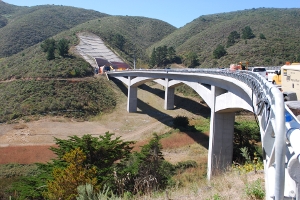 The Devil’s Slide project bridges span Shamrock Ranch, connecting the northern portals of each of the tunnels to Highway One. (Credit: Sheraz Sadiq)
The Devil’s Slide project bridges span Shamrock Ranch, connecting the northern portals of each of the tunnels to Highway One. (Credit: Sheraz Sadiq)
At the punch through event on Oct. 1, Caltrans District 4 Director Bijan Sartipi praised members of his staff and acknowledged the efforts of environmentalists who refused to accept a freeway bypass alternative at Devil’s Slide. Political leaders reminisced about the turns and twists in the history of Devil’s Slide.
“In 1980, I was a 28 year-old who had gotten recently elected to the board of supervisors and the Devil’s Slide issue was starting to bubble up again,” said U.S. Rep. Jackie Speier, D-San Mateo. “And the community said ‘why not bore a hole through here, and make a tunnel?’ It was dismissed, frankly, but then it gained steam and they qualified an initiative on the ballot. The public rose up and said there is a better way.”
The problems at Devil’s Slide date back more than 70 years.
In 1937, a stretch of Highway One, from Pacifica to Half Moon Bay, opened to the public, allowing motorists an efficient way to zip up and down the San Mateo County coast. For about 600 feet, the road crosses Devil’s Slide, a rocky and unstable sheer cliff cresting 900 feet above the Pacific Ocean. But only a few years after the road opened, it was closed for days at a time, particularly during the winter months, when heavy rains sent rocks and dirt tumbling from the face of the cliff to the road below.
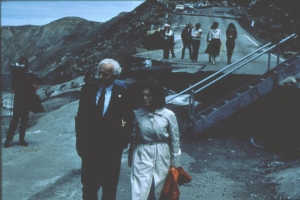 San Mateo Congressman Tom Lantos with his wife, Annette, touring the damaged roadbed at Devil’s Slide in the winter of 1980. (Credit: Zoe Kersteen-Tucker)
San Mateo Congressman Tom Lantos with his wife, Annette, touring the damaged roadbed at Devil’s Slide in the winter of 1980. (Credit: Zoe Kersteen-Tucker)
Ken Lajoie is a retired Research Geologist with the U.S. Geological Survey who lives in Menlo Park. He began mapping the rates of coastal erosion in San Mateo County in 1970. Lajoie cited several reasons why Devil’s Slide is so unstable.
The rocks exposed on the cliff face are made of granite, interbedded shale and sandstone. While granite is stable, “shales and sandstones are very unstable and produce both shallow and deep-seated slides, especially during and after the rainy seasons,” he said.
Added to that are earthquakes. Seismic activity triggers landslides. Lajoie said that a deep-seated slide, which extends from the top of the cliff almost down to the beach, is responsible for the slippage and movement of the Devil’s Slide roadbed that has resulted in the lengthy road closures over the years.
Because of this unpredictable movement of soil and rocks at Devil’s Slide, the state and San Mateo County adopted a plan in 1958 to build a freeway to permanently bypass it.
The six-lane freeway would extend for seven miles, from Linda Mar in Pacifica all the way to the Half Moon Bay airport, up and over Montara Mountain. The freeway bypass was a key step in supporting a housing and development corridor similar to Daly City, but along the San Mateo coast, with interchanges that would lead from San Francisco all the way down to San Luis Obispo.
According to a Division of Highways Project Report from 1960, state highway engineers didn’t intend to start work on the freeway bypass. Instead, they wanted to wait until a “major slipout or slide occurs at Devil’s Slide” so that they could tap federal emergency funds to build the bypass.
In 1968, Lennie Roberts joined the board of an environmental grassroots organization called the Committee for Green Foothills, founded originally in 1962 to fight urban sprawl in Palo Alto. A friend, Ollie Mayer, who was a member of the Sierra Club and an engineer by training, had gotten hold of the original highway construction plans and shared them with Roberts and other environmentalists.
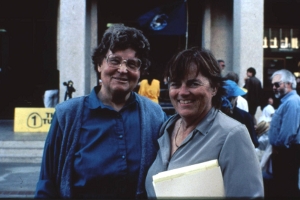 ‘Yes on Measure T’ supporters Lennie Roberts (right) and Ollie Mayer at a Redwood City press conference held in 1996. (Credit: Zoe Kersteen-Tucker)
‘Yes on Measure T’ supporters Lennie Roberts (right) and Ollie Mayer at a Redwood City press conference held in 1996. (Credit: Zoe Kersteen-Tucker)
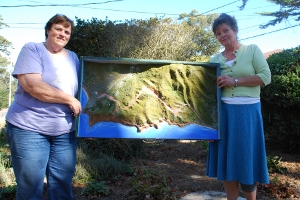 Lennie Roberts (left) and Zoe-Kersteen Tucker hold a model of the proposed freeway bypass over Montara Mountain. (Credit: Sheraz Sadiq)
Lennie Roberts (left) and Zoe-Kersteen Tucker hold a model of the proposed freeway bypass over Montara Mountain. (Credit: Sheraz Sadiq)
They were appalled by what they saw as a sure-fire plan to cover the rural coast with urban sprawl and pave its scenic hills. And with good reason: San Mateo County had drawn up plans in 1960 that called for 200,000 residents on the San Mateo coast by 1990.
“There was a whole set of freeways that were anticipated to come across the hill in several locations, and that was going to facilitate turning the coast side into what we already have on the bay side,” said Roberts.
The Westinghouse Corporation at the time had bought up 8,000 acres of prime real estate around Half Moon Bay, Montara and El Granada. Most of the land has since been acquired by the Peninsula Open Space Trust, a non-profit land preservation group.
“There was no need for that giant freeway, and we didn’t want it to be a situation where ‘if you build it, they will come,’ creating this enticement to add more development above and beyond what this area can sustain,” said Zoe Kersteen-Tucker, a Moss Beach resident and lead organizer for the successful, citizen-led initiative on a tunnel bypass at Devil’s Slide.
Although developers and state highway officials pushed through similar -projects in the 1950s and 1960s, a fledgling environmental movement was taking off, from the steps of Capitol Hill to the cliffs of California’s coast.
In 1972, California voters passed Proposition 20, the California Coastal Initiative, which limited development along the coast. Four years later, state lawmakers enacted the California Coastal Act, which established the California Coastal Commission to review and approve building plans, including highway construction, along the coast. The act also mandated that rural stretches of Highway One along the coast had to be limited to just two lanes.
Unfazed, Caltrans responded by claiming that the freeway bypass would be striped to only two lanes, though it would still be graded for a width between 79 and 101 feet, making it wider than the Golden Gate Bridge.
“It would have been the widest two-lane road in the U.S.,” said Chris Thollaug, a Montara resident and former spokesman for the Sierra Club.
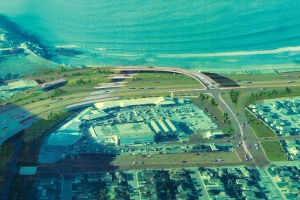 In 1974, Caltrans created this illustration of the proposed six-lane freeway bypass of Devil’s Slide. According to Mitch Reid, Caltrans never made this image available to the public. (Credit: Mitch Reid)
In 1974, Caltrans created this illustration of the proposed six-lane freeway bypass of Devil’s Slide. According to Mitch Reid, Caltrans never made this image available to the public. (Credit: Mitch Reid)
But now environmentalists had powerful new legal tools to challenge the massive freeway bypass.
In 1972, the Sierra Club, the Committee for Green Foothills, and other environmentalists successfully sued Caltrans for failing to prepare an Environmental Impact Statement, which they were required to do under a federal law signed by Richard Nixon in 1970 known as the National Environmental Policy Act, or NEPA.
Even though Highway One is a state road, Caltrans had received federal funds for road repairs at Devil’s Slide, so the agency was subject to NEPA provisions.
But despite the court ruling, Caltrans chose not to prepare the Environmental Impact Statement for the freeway bypass.
“They put the whole thing aside and did nothing until they hoped there was an emergency when the road would slide out and they could proceed with the bypass as an emergency project,” said Roberts.
About this time, the idea of a tunnel bypass at Devil’s Slide first came to light.
Ken Lajoie, the former USGS geologist, received a letter from a Montara resident inquiring what could be done about Devil’s Slide. In his reply, he outlined four or five options, including “boring a tunnel right behind it, which would solve the problem forever.” After Ollie Mayer of the Sierra Club also contacted Lajoie to get his thoughts on Devil’s Slide, she presented the tunnel idea to Caltrans in 1973 but the agency dismissed it.
In the late ‘70s and early ‘80s, when Jerry Brown was governor, the officials he appointed at Caltrans clashed with the pro-building, pro-freeway sentiment that had prevailed within the agency. Norman Kelley, the Caltrans District 4 Director, unveiled a plan to the San Mateo County Board of Supervisors and environmentalists to permanently repair Devil’s Slide by excavating the unstable material from the rocky bluff and tucking the road 250 feet inland to a more stable, bedrock section of Devil’s Slide.
Some of the excavated dirt and rock would be dumped into the Pacific Ocean but most of it would be placed on the rocky slope below the road to help stabilize it.
“When you excavate the material from above the road, you are reducing the driving force on the slide and when you put it at the toe of the slide, it acts as a buttress and essentially stabilizes the landslide, the mass that moves,” said Bill Bechtell, a retired geotechnical and civil engineer and member of the Sierra Club who opposed the freeway bypass.
Though environmentalists were encouraged by this ‘Marine Disposal Alternative’ proposal, the political winds shifted once again at Caltrans. Governor George Deukmejian took office in 1983, and he “put the Caltrans engineers back in charge again – the same people who designed the freeway bypass,” said Roberts.
The Marine Disposal Alternative was ultimately scuttled when federal officials who manage the Monterey Bay National Marine Sanctuary refused to endorse it, claiming irreparable harm to marine life from the dumping of excavated material into the ocean.
In the early ‘80s, Caltrans bowed to pressure from the San Mateo County Board of Supervisors and amended the original freeway bypass design. The new Martini Creek alignment was four and a half miles long, running from Linda Mar Boulevard in Pacifica, over Montara Mountain, past Martini Creek to the south, and would meet up with Highway One again at Montara State Beach. The new route would also run through McNee Ranch State Park.
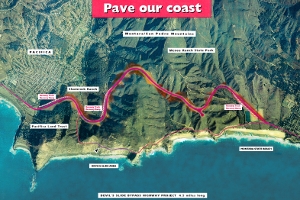 An illustration that appeared in ‘Yes on Measure T’ newsletters in 1995 and 1996 showing the Martini Creek freeway bypass alignment over Devil’s Slide. (Credit: Mitch Reid)
An illustration that appeared in ‘Yes on Measure T’ newsletters in 1995 and 1996 showing the Martini Creek freeway bypass alignment over Devil’s Slide. (Credit: Mitch Reid)
Even though Caltrans claimed the new alignment would also be striped for 2 lanes, it would be paved to accommodate four lanes. The steepness of the road required as many as 11 cuts and fills up to 106 feet wide and 275 feet high.
“I was appalled when I saw this,” said Bechtell. “I live in Montara and it would have destroyed our community, with the freeway coming through a state park and adjacent open space. You would have the noise from truck traffic and it was not something I wanted to see happen.”
In 1986, the San Mateo County Board of Supervisors voted 3-2 to support the Martini Creek Alignment, and the Coastal Commission voted 7-5 to support it as well. The Sierra Club, the Committee for Green Foothills and the owners of Shamrock Ranch sued Caltrans, claiming that the agency had violated a federal highway law that required an assessment of the impact of highway construction projects on nearby parklands.
A federal judge agreed, stating that Caltrans had failed to study the impact of noise from freeway construction on camp grounds at McNee Ranch State Park.
“Our conclusion was that it didn’t represent a significant noise impact but we followed through with the court order and did additional noise studies,” said Ed Pang, a senior environmental planner at Caltrans.
In January 1995, a winter storm caused a 160-foot section of road to buckle and slip five feet. The damage resulted in a road closure that lasted more than five months – the longest closure in the history of Devil’s Slide – and cost more than $3 million to repair, making life miserable for local residents.
“I had moved my business to Moss Beach a month before the slide went out,” said Mitch Reid, an environmental product designer and resident of Pacifica. “So I had to drive all the way from Pacifica, taking Highway 280 then 92 heading west and then back to Highway One to get to my shop. So what was a 10 minute drive turned into as much as an hour and a half drive for me.”
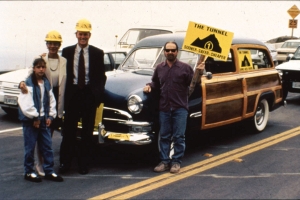 Mitch Reid, with sign, and other pro-tunnel supporters at the reopening of Devil’s Slide in 1995. (Credit: Zoe Kersteen-Tucker)
Mitch Reid, with sign, and other pro-tunnel supporters at the reopening of Devil’s Slide in 1995. (Credit: Zoe Kersteen-Tucker)
With nerves fraying among commuters, pressure to come up with a solution began to mount.
“I was out there on the coast all the time and people were livid with what was happening,” said former county supervisor Ted Lempert. “A lot of the political establishment said this is even more reason for the freeway bypass.”
Lempert, with the approval of the four other county supervisors, convened a panel of six engineers and geologists to offer an independent study of Devil’s Slide and come up with the most effective solution for it.
“At an early meeting, we presented them with Caltrans’ bypass plan,” said Lempert. “I asked them what we should do and several of them said, ‘why don’t you look at a tunnel?’”
In March 1995, the panel formally recommended building a tunnel, which they estimated would be 4,600 feet long, and take two to three years to construct at a cost of $50 to $70 million. Caltrans claimed that a tunnel wasn’t feasible at Devil’s Slide and that it was too expensive to pursue, with an estimated cost of $126 million compared to roughly $90 million for the freeway bypass.
Lempert pressed Caltrans for information to further clarify why the freeway bypass was more feasible than a tunnel.
“I remember it being pretty ugly and there were a couple of times I asked for information but I couldn’t get,” he said. “It was a classic example of a bureaucracy telling the public official to go to hell as they knew they had the support of the political establishment and so they were arrogant in the early days.”
Ruben Barrales, another member of the board of supervisors, allied with Lempert in pushing for the tunnel. But Lempert and Barrales lost out to three other supervisors on the board who voted to stick with the freeway bypass.
“Caltrans had this unwillingness to seriously explore the tunnel alternative even though a layperson knew of tunnels across the country and world,” said Lempert. “It was bizarre that they wouldn’t consider it. They were about bridging bridges and highways and tunnels is something they didn’t do, that was the impression I got.”
With a lack of unified support from elected officials, and their legal options running out, the environmentalists realized that they would have to launch a massive outreach campaign to keep the tunnel option alive. They collected 34,000 signatures to put the issue on the county ballot.
They printed ‘Think Tunnel’ bumper stickers and blanketed San Mateo County with newsletters and fact sheets.
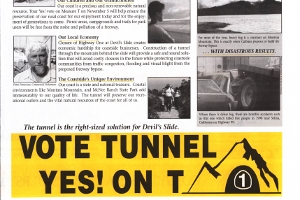 Excerpt from a pro-tunnel, ‘Yes on Measure T’, newsletter. (Credit: Zoe Kersteen-Tucker)
Excerpt from a pro-tunnel, ‘Yes on Measure T’, newsletter. (Credit: Zoe Kersteen-Tucker)
In August 1995, the Federal Highway Administration told Caltrans that it had to conduct a new study to evaluate the tunnel in comparison to the freeway bypass.
Zoe Kersteen-Tucker recalled at the time a comment a Caltrans spokesperson made to a news reporter. “He said, ‘Sure we’ll evaluate the tunnel proposal and say it’s too expensive.’” She added that “there was such hubris on the part of Caltrans, a public entity that is supported by tax dollars.”
Roughly six months before the vote on Measure T, the environmentalists’ persistence finally paid off. Mitch Reid had been working on the pro-tunnel campaign and had faxed over a Freedom of Information Act request to the Caltrans office in Oakland. The next day, he received a dozen pages of documents, including a 1993 internal memo from James Roberts, the then-Chief of the Division of Structures at Caltrans.
“That was the smoking gun,” said Reid. “The most important line in that memo said that if the purpose is to bypass the slide, then alternative number one should be selected, a two lane, single bore tunnel. Basically, it was very clear that they were trying to say that the tunnel was twice as expensive as the bypass, but when you looked at this document, it showed that they were head to head.”
In November 1996, Measure T passed with a resounding 74 percent of the vote. The Local Coastal Plan for San Mateo county was changed and the tunnel option became the preferred bypass of Devil’s Slide.
“I have been in elected office for 22 years and this was by far the most inspirational thing I ever worked on. It was a triumph of common sense,” said Lempert.
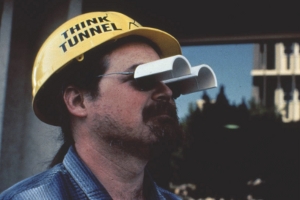 A ‘Yes on Measure T’ supporter at a Redwood City press conference held in 1996(Credit: Zoe Kersteen-Tucker)
A ‘Yes on Measure T’ supporter at a Redwood City press conference held in 1996(Credit: Zoe Kersteen-Tucker)
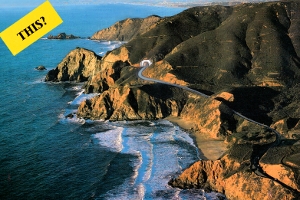 An illustration made in 1996 by a pro-tunnel supporter of the tunnel bypass of Devil’s Slide. (Credit: Mitch Reid)
An illustration made in 1996 by a pro-tunnel supporter of the tunnel bypass of Devil’s Slide. (Credit: Mitch Reid)
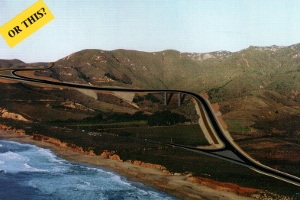 An illustration made by a pro-tunnel supporter in 1995 of the Caltrans proposed freeway bypass of Devil’s Slide. (Credit: Chuck Kozak)
An illustration made by a pro-tunnel supporter in 1995 of the Caltrans proposed freeway bypass of Devil’s Slide. (Credit: Chuck Kozak)
“Once the people spoke, Caltrans got it and they changed their attitude and approach and they became ‘can do’ instead of ‘won’t do,’” said Roberts. “We now have strong friendships with people at Caltrans.”
But funds were needed to ensure the construction of the tunnel. In the early ‘80s, San Mateo Congressman Tom Lantos had secured $50 million in federal emergency funds for road repairs at Devil’s Slide. After the passage of Measure T, U.S. Senator Barbara Boxer, D-Calif., was successful in getting Devil’s Slide to be designated as a “continuing and ongoing federal emergency,” allowing the total cost of the tunnel to come from federal emergency relief funds.
“It allowed the tunnel project to step out of the state transportation improvement program and get in line for emergency relief funds. It was a huge hurdle that we cleared to get the actual money to build the tunnel,” said Kersteen-Tucker.
“If we didn’t have the assistance at the federal level, we would be in lawsuits about these various alternatives. We would have continuing landslides that would close the roads, and kids couldn’t get to schools and people couldn’t get to work,” said Congresswoman Jackie Speier.
Skip Sowko is the project manager on the Devil’s Slide tunnel project. After the passage of Measure T, he oversaw the lengthy process of environmental review of a tunnel. Decisions were made on the aesthetics of the tunnel design, revegetating moved earth and how best to offset the impact of the tunnel construction on a population of endangered California red-legged frogs at Shamrock Ranch, an endangered wildflower called Hickman’s cinquefoil, the dusky-footed woodrat and migratory birds like peregrine falcons.
“This project, when it was reevaluated, allowed the other options to become competitive and it changed the whole environment of doing construction work,” he said. “I listened to a lot of people at meetings. Good design requires good input and we’re interested in hearing that input, understanding those concerns, so that we can build the best possible project.”
“I think government, like the private sector, is becoming more consumer-focused and more nimble,” said Lempert. “It’s the world we live in today, and the old way of doing things has been overturned.”
As for the treacherous stretch of road at Devil’s Slide, a new, more placid incarnation lies ahead. Caltrans will give the bypassed stretch of road and 70 nearby acres to San Mateo County to operate as a park and a pathway reserved for hikers and bicyclists when the Devil’s Slide tunnels open to motorists in 2012.
At the recent event when Caltrans crews punched through the northbound tunnel, and jubilant applause rose from the crowd as the digger ripped through the rock, Zoe Kersteen-Tucker reflected afterward on the significance of the day.
“It represents power to the people,” she said. “You can’t accept no for an answer and if you have a vision for something that really needs to happen to protect future generations, you have to work as hard as you can and other people start working with you. That’s what we did here and it was the power of that vision that carried us through to this day.”
[jwplayer config=”QUEST Audio Player” skin=”http://ww2.kqed.org/quest/wp-content/themes/quest/glow.zip” file=”http://www.kqed.org/.stream/anon/radio/quest/2007/03/2007-03-30-quest.mp3″ ]
Listen to the QUEST radio story about Devil’s Slide.
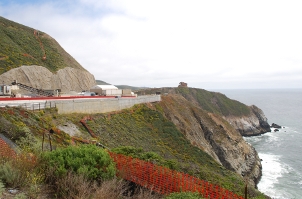 Devil’s Slide is a rocky, unstable bluff jutting above and below a stretch of Highway One between the coastal communities of Pacifica and Montara. (Credit: Jenny Oh)
Devil’s Slide is a rocky, unstable bluff jutting above and below a stretch of Highway One between the coastal communities of Pacifica and Montara. (Credit: Jenny Oh)